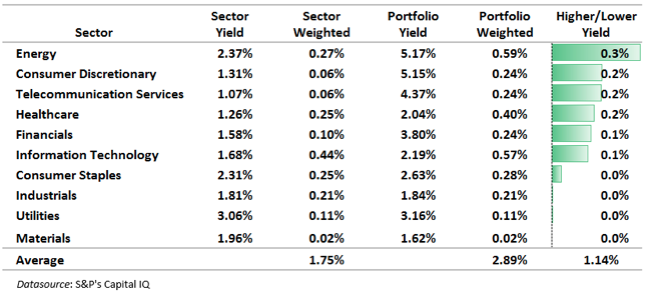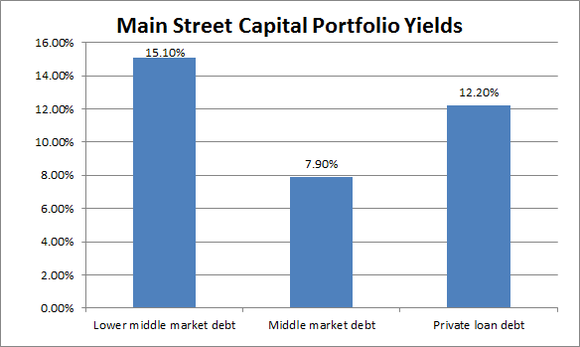Weighted average portfolio yield
Post on: 18 Апрель, 2015 No Comment

The weighted average of the yield of all the bonds in a portfolio .
Similar financial terms
For amortizing securities, investors do not talk in terms of a bond’s maturity since its principal is made over time. This is because the stated maturity of such securities only identifies when the final principal payment will be made.
The average remaining term of the mortgages underlying a MBS.
The Weighted average maturity (WAM) of a MBS is the weighted average of the remaining terms to maturity of the mortgages underlying the collateral pool at the date of issue, using as the weighting factor the balance of each of the mortgages as of the issue date.
The weighted average of the gross interest rate of the mortgages underlying the pool as of the pool issue date, with the balance of each mortgage used as the weighting factor.
The weighted average cost of capital (WACC) is the expected return on a portfolio of all the firm’s securities when debt, equity and tax shields are taken into account. Used as a hurdle rate for capital investment.
An index of a group of securities computed by calculating a weighted average of the returns on each security in the index, with the weights proportional to outstanding market value.
The sum of n numbers divided by n.
The Dow Jones Industrial Average (DJIA) is based on a portfolio consisting of 30 blue-chipi stocks in the United States. The weights given to the stocks are proportional to their prices.
The Nikkei 225 Stock Average (NIKKEI 225) is based on a portfolio of 225 of the largest stocks trading on the Tokyo Stock Exchange. Stocks are weighted according to their prices.
The moving averages is one of the oldest and most popular of technical analysis tools. A simple moving average is calculated by adding together the closing price of a financial instrument over a certain number of days and then dividing the sum by the number of days involved. So, for example, the seven day average for a share price would be calculated by taking seven days worth of data, adding them together and dividing by seven.
To calculate the movingaverage:
1. Take the f.
The mean, calculated at any time over a past period of fixed length.
Percentage of the time you are successful (from baseball).
The U.S.’ largest pension funds have accumulated major-league batting averages in selecting top-performing domestic equity and fixed-income money managers during the last 5 years.
Pensions & Investments. May 2, 1994, p.1.
A portfolio that provides the superior expected return for a given level of risk
A vega-neutral portfolio has an asset combination which implies a vega of zero.
A zero-beta portfolio is constructed to have zero systematic risk, similar to the risk-free asset, that is, having a beta of zero. (i.e. in most cases, we assume the beta of debt to be zero).
A zero-investment portfolio consists of zero net value because of a balanced establishment between long and short position, usually in the context of an arbitrage strategy.
A strategy that uses available information and forecasting techniques to seek a better performance than a portfolio that is simply diversified broadly. Related: passive portfolio strategy.
A portfolio spread out over many securities in such a way that the weight in any security is small. The risk of a well-diversified portfolio closely approximates the systemic risk of the overall market, the unsystematic risk of each security having been diversified out of the portfolio.
An indexing strategy that is linked to active management through the emphasis of a particular industry sector, selected performance factors such as earnings momentum, dividend yield, P/E ratio, or selected economic factors such as interest rates and inflation.
A strategy in which a portfolio is designed to achieve the performance of some predetermined liabilities that must be paid out in the future.
A portfolio constructed to match an index or benchmark.
Weighted sum of the covariance and variances of the assets in a portfolio.
For an investment company, an annualized rate found by dividing the lesser of purchases and sales by the average of portfolio assets.
An investor’s choice of a risky investment portfolio is separate from his attitude towards risk.
The expected return/standard deviation pairs of all portfolios that can be constructed from a given set of assets.
The rate of return computed by first determining the cash flows for all the bonds in the portfolio and then finding the interest rate that will make the present value of the cash flows equal to the market value of the portfolio.
A strategy using a leveraged portfolio in the underlying stock to create a synthetic put option. The strategy’s goal is to ensure that the value of the portfolio does not fall below a certain level.
A collection of investments, real and/or financial.
A market index portfolio.
A strategy that involves minimal expectational input, and instead relies on diversification to match the performance of some market index. A passive strategy assumes that the marketplace will reflect all available information in the price paid for securities, and therefore, does not attempt to find mispriced securities.
An efficient portfolio most preferred by an investor because its risk/reward characteristics approximate the investor’s utility function. A portfolio that maximizes an investor’s preferences with respect to return and risk.
A customized benchmark that includes all the securities from which a manager normally chooses, weighted as the manager would weight them in a portfolio.
Principles underlying the analysis and evaluation of rational portfolio choices based on risk-return trade-offs and efficient diversification.
The portfolio of risky assets with lowest variance.
The collection of all efficient portfolios, graphically referred to as the Markowitz efficient frontier.
Also called a mean-variance efficient portfolio, a portfolio that has the highest expected return at a given level of risk.
A portfolio consisting of all assets available to investors, with each asset held -in proportion to its market value relative to the total market value of all assets.
A portfolio that includes risky assets purchased with funds borrowed.
The entire portfolio, including risky and risk-free assets.

The total yield on a bond obtained by equating the bond’s current market value to the discounted cash flows promised by the bond. Also referred to as actuarial yield or just yield.
The yield curve, which plots the term structure, shows the relationship between yield (interest rate) and maturity for a set of similar securities. Typically, different yield curves are drawn for zero-coupon bonds (zero-coupon yield curve) and for coupon bonds quoted at par (par yield curve).
In general, the yield is the return on an investor’s capital investment. For bonds it is the coupon rate of interest divided by the purchase price, called current yield. Also, the rate of return on a bond, taking into account the total of annual interest payments, the purchase price, the redemption value, and the amount of time remaining until maturity.
A stock’s daily percentage summary of yield, calculated by dividing annual dividend per share by the day’s closing stock price.
The percentage rate of a bond or note, if you were to buy and hold the security until the call date. This yield is valid only if the security is called prior to maturity. Generally bonds are callable over several years and normally are called at a slight premium. The calculation of yield to call is based on the coupon rate, length of time to the call and the market price.
Strategies that involve positioning a portfolio to capitalize on expected changes inyield spreads between sectors of the bond market.
The quotient of two bond yields.
Positioning a portfolio to capitalize on expected changes in the shape of the Treasury yield curve.
Models that can incorporate different volatility assumptions along the yield curve, such as the Black-Derman-Toy model. Also called arbitrage-free option-pricing models.
The effective, or true, annual rate of return. The APY is the rate actually earned or paid in one year, taking into account the affect of compounding. The APY is calculated by taking one plus the periodic rate and raising it to the number of periods in a year. For example, a 1% per month rate has an APY of 12.68% (1.01^12).
A change in the yield curve where the spread between the yield on a long-term and short-term Treasury has increased.
Buying long-term bonds in anticipation of capital gains as yields fall with the declining maturity of the bonds.
Generally referring to bonds, the yield required by the marketplace to match available returns for financial instruments with comparable risk.
In a purchase and sale, the yield to maturity at which the underwriter offers to sell the bonds to investors.
The ratio of the yield spread to the yield level.
Yield assuming that coupon payments are invested at the going market interest rate at the time of their receipt and rolled over until the bond matures.
Moving to higher yield bonds.
A shift in the yield curve in which the change in the yield on all maturities is the same number of basis points. In other words, if the 3 month T-bill increases 100 basis points (one percent), then the 6 month, 1 year, 5 year, 10 year, 20 year, and 30 year rates increase by 100 basis points as well.
A shift in the yield curve in which yields do not change by the same number of basis points for every maturity.
Zero-coupon, callable, putable, convertible bond invented by Merrill Lynch & Co.
The extra advantage that firms derive from holding the commodity rather than the future.
True interest cost expressed on the basis of a 365-day year.
For bonds or notes, the coupon rate divided by the market price of the bond.














